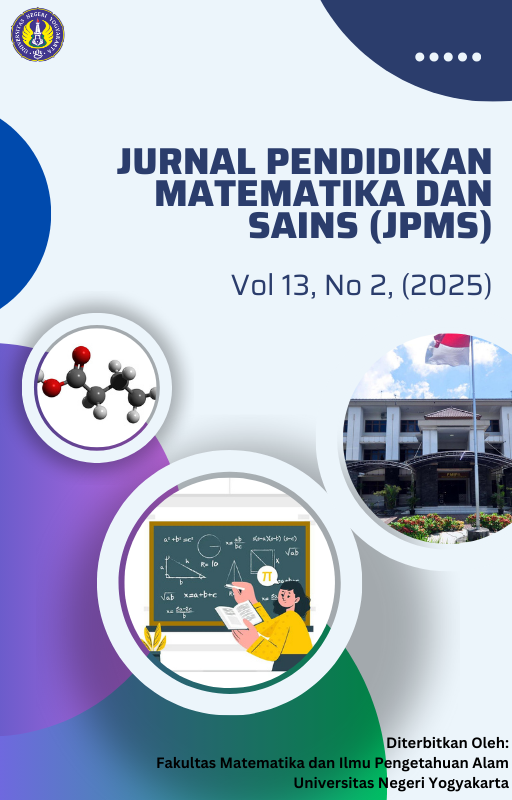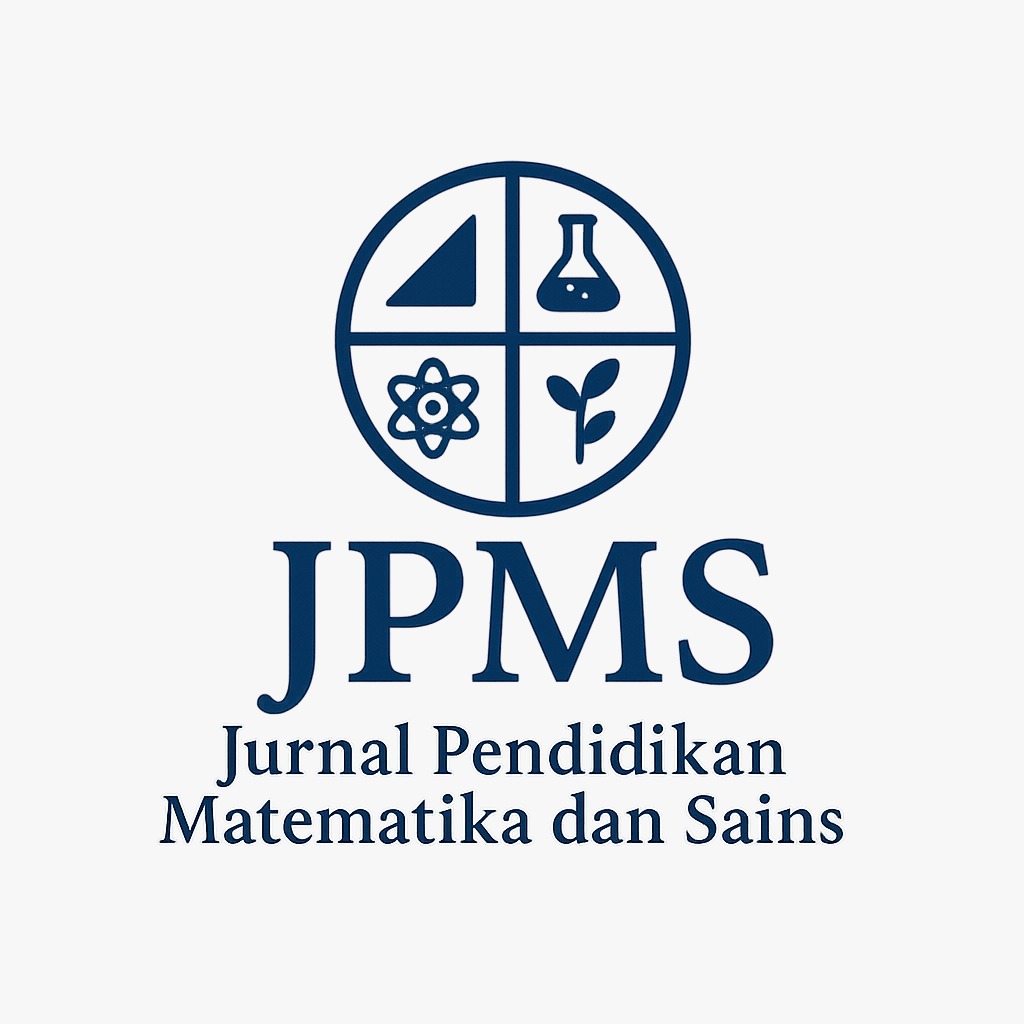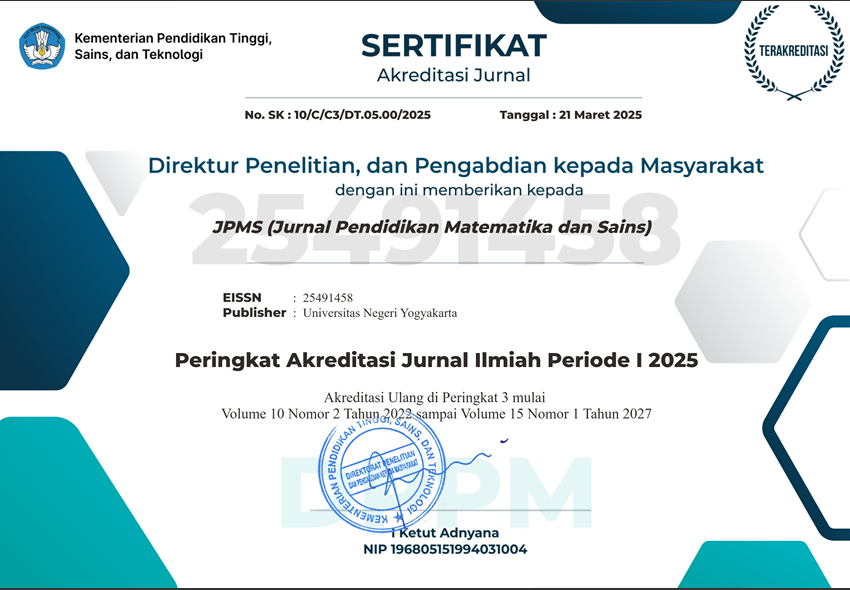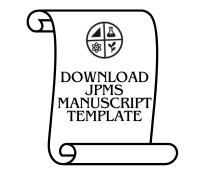Measurement of Sound Speed Using a Frequency Generator-assisted Resonance Tube for STEM-based Learning
DOI:
https://doi.org/10.21831/jpms.v13i2.86417Keywords:
Resonance tube, Sound speed, STEMAbstract
This study investigates the measurement of the speed of sound in air using a resonance tube assisted by a smartphone-based frequency generator, designed to support STEM-based learning. The experiment follows a quantitative approach, with the length of the air column as the independent variable and the speed of sound as the dependent variable. Control frequencies of 495 Hz, 755 Hz, 1010 Hz, 1270 Hz, and 1530 Hz were generated via a mobile application. Resonance points were identified by observing the peak sound intensity using a digital sound level meter, which indicated the formation of standing waves. The results showed a strong linear relationship between wavelength (λ) and wave period (T), with regression equations λ = 347.62T + 0.0098 (open pipe) and λ = 361.59T − 0.0176 (closed pipe), each with a correlation coefficient of R = 0.99. At room temperature (24.4°C), the measured speed of sound was (347.6 ± 0.2) m/s for the open pipe and (361.6 ± 0.1) m/s for the closed pipe. These results demonstrate that low-cost, smartphone-assisted setups can produce accurate, reliable data. This method enhances student engagement and understanding of acoustic phenomena, providing an accessible and effective model for implementing hands-on STEM-based learning in physics education.
References
Astuti, I. A. D. (2016). Pengembangan Alat Eksperimen Cepat Rambat Bunyi Dalam Medium Udara Dengan Menggunakan Metode Time Of Flight (Tof) Dan Berbantuan Software Audacity. Unnes Physics Education Journa, 5(3), 18–24. http://journal.unnes.ac.id/sju/index.php/upej
Beers, S. Z. (2011). 21st Century Skills: Preparing Students for THEIR Future. Kappa Delta Pi Record.
Bybee, R. W. (2013). The Case for Education: STEM Challenges and Opportunities. In NSTA (National Science Teachers Assocation). NSTA Press. www.nsta.org/permissions.
Djonoputro, B. D. (1984). Teori Ketidakpastian : Menggunakan Satuan SI. Institut Teknologi Bandung.
Gabunilas, L. M., Santos, K. J. M., Buar, C. L., Castillo, J. M. L., & Pili, U. B. (2022). Improvising an apparatus for teaching sound waves using smartphones. Physics Education, 58(1), 15014. https://doi.org/10.1088/1361-6552/ac9efb
González, M., Huete, F., Manso, J., Da Silva, J. B., Martínez, Ó., Rochadel, W., Cañedo, J. C., Esteban, D., & González, M. A. (2015). Doing physics experiments and learning with smartphones. ACM International Conference Proceeding Series, October, 303–310. https://doi.org/10.1145/2808580.2808626
Haleem, A., Javaid, M., Qadri, M. A., & Suman, R. (2022). Understanding the role of digital technologies in education: A review. Sustainable Operations and Computers, 3(February), 275–285. https://doi.org/10.1016/j.susoc.2022.05.004
Hellesund, S. (2019). Measuring the speed of sound in air using a smartphone and a cardboard tube. Physics Education, 54(3). https://doi.org/10.1088/1361-6552/ab0e21
Klein, P., Hirth, M., Kuhn, J., Muller, A., & Grober, S. (2014). Classical experiments revisited : smartphones and tablet PCs as experimental tools in acoustics and optics. Physics Education, 412(49), 4. https://iopscience.iop.org/article/10.1088/0031-9120/49/4/412/meta
Kuhn, J., & Vogt, P. (2013). Analyzing acoustic phenomena with a smartphone microphone. The Physics Teacher, 51(2), 118–119. https://doi.org/10.1119/1.4775539
Kuhn, J., Vogt, P., & Hirth, M. (2014). Analyzing the acoustic beat with mobile devices. The Physics Teacher, 52(4), 248–249. https://doi.org/10.1119/1.4868948
Kustijono, R. (2011). Implementasi Student Centered Learning Dalam Praktikum Fisika Dasar. Jurnal Penelitian Fisika Dan Aplikasinya (JPFA), 1(2), 19. https://doi.org/10.26740/jpfa.v1n2.p19-32
Lukum, A. (2013). Evaluation of Science Learning Supervision on Secondary Schools. International Journal of Education, 5(4), 61. https://doi.org/10.5296/ije.v5i4.4240
Lutfiyah, A., Adam, A. S., Suprapto, N., Kholiq, A., & Putri, N. P. (2018). Correction factors in determining speed of sound among freshmen in undergraduate physics laboratory. Journal of Physics: Conference Series, 997(1). https://doi.org/10.1088/1742-6596/997/1/012024
Mahdi, Z. S., & Al-jumaily, K. J. (2012). Atmospheric Effects on Sound Waves Propagation. Iraqi Journal of Science, May 2012.
Permendikbud. (2018). Permendikbud RI Nomor 37 tahun 2018 tentang Perubahan atas Peraturan Menteri Pendidikan dan Kebudayaan Nomor 24 tahun 2016 tentang Kompetensi Inti dan Kompetensi Dasar Pelajaran pada Kurikulum 2013 pada Pendidikan Dasar dan Pendidikan Menengah. JDIH Kemendikbud, 2025, 1–527.
Prabowo, F. L., & Sucahyo, I. (2018). Pengembangan Media Hukum Melde Berbasis Aplikasi Physics Toolbox Sensor Suite Pada Materi Gelombang Stasioner. Jurnal Inovasi Pendidikan Fisika, 07(02), 165–170.
Rahmawati, P. E. A., & Budiningarti, H. (2018). Penerapan Model Pengajaran Langsung Pada Materi Gerak Harmonik Sederhana Untuk Meningkatkan Hasil Belajar Siswa. Jurnal Inovasi Pendidikan Fisika, 07(01), 55–59.
Rismaningsih, F., Setiono, F. E., Gideon, S., Rabiudin, Sujarwanto, E., Irwanto, R., Malik, Y., Lusiani, & Setiawan, J. (2021). Fisika Dasar Mekanika. Media Sains Indonesia.
Roehrig, G. H., Moore, T. J., Wang, H. H., & Park, M. S. (2012). Is Adding the E Enough? Investigating the Impact of K-12 Engineering Standards on the Implementation of STEM Integration. School Science and Mathematics, 112(1), 31–44. https://doi.org/10.1111/j.1949-8594.2011.00112.x
Sakamoto, S., Asakura, T., Ueno, K., Sakimoto, Y., Satoh, F., & Tachibana, H. (2006). Visualization of acoustic resonance phenomena using Kundt’s dust figure method. The Journal of the Acoustical Society of America 120, 3070. https://doi.org/https://doi.org/10.1121/1.4787366
Serway, R. A., & Jewett, J. W. (2017). Physics for Scientists and Engineers with Moder Physics Tenth Edition (Issue 2007).
Tipler, P. A. (1991). Physics for Science and Engineering Volume 1 Third Edition. Erlangga.
Vogt, P., Kuhn, J., & Neuschwander, D. (2014). Determining ball velocities with smartphones. The Physics Teacher, 52(6), 376–377. https://doi.org/10.1119/1.4893100
Wu, T. T., Lee, H. Y., Wang, W. S., Lin, C. J., & Huang, Y. M. (2023). Leveraging computer vision for adaptive learning in STEM education: effect of engagement and self-efficacy. International Journal of Educational Technology in Higher Education, 20(1). https://doi.org/10.1186/s41239-023-00422-5
Yasid, A., Yushardi, & Handayani, D. (2016). Pengaruh Frekuensi Gelombang Bunyi Terhadap Perilaku Lalat Rumah (Musca domestica). Jurnal Pembelajaran Fisika, 5(2), 190–196.
Young, H. D., & Freedman, R. A. (2020). University Physics with Modern Physics Fifteenth Edition in SI Units. Pearson Education Limited.
Downloads
Published
How to Cite
Issue
Section
Citation Check
License

This work is licensed under a Creative Commons Attribution-ShareAlike 4.0 International License.
Jurnal Pendidikan Matematika dan Sains allows readers to read, download, copy, distribute, print, search, or link to its articles' full texts and allows readers to use them for any other lawful purpose. The journal allows the author(s) to hold the copyright without restrictions. Finally, the journal allows the author(s) to retain publishing rights without restrictions
- Authors are allowed to archive their submitted article in an open access repository
- Authors are allowed to archive the final published article in an open access repository with an acknowledgment of its initial publication in this journal

This work is licensed under a Creative Commons Attribution-ShareAlike 4.0 Generic License.





